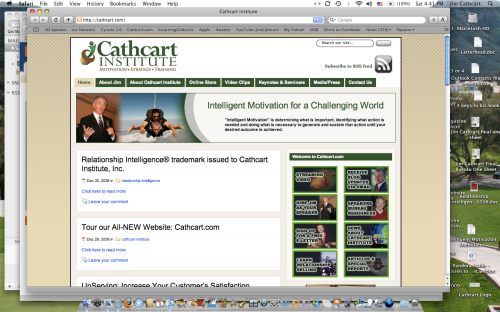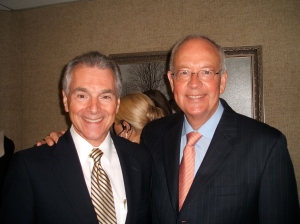by Jim Cathcart

There must be 100,000 trainers, speakers and authors out there teaching people how to be more successful in dealing with others. And maybe I’m being small minded in choosing such a low number.
All I know is, when I started teaching “interpersonal communication” in the mid 1970s there were very few of us doing so. The Dale Carnegie Course still seemed new to many people despite having existed for a generation. Clients were still surprized when we suggested that they actually teach people how to: listen, communicate two-ways, understand personality differences, and manage tension levels in their communication.
In fact, in 1976 when I joined the National Speakers Association there were only a couple of hundred members. Today they have over 3,600 members. The American Society for Training & Development, ASTD, was also fairly new when I joined them in 1974. They, too, are now an international organization with tens of thousands of members.
So, in light of the fact that there is a multitude of resources to help you learn “People Skills”, let’s take it to the next level. Relationship Intelligence ™.
Premise: Your life is a series of Relationships
Our lives are lived through interactions with others.
Conclusion: If you change the mix, quality or quantity of your relationships then you will, in fact, change your life experience.
So, being more Intelligent about which relationships you develop and which you do not will have a profound effect on the quality of your life.
Complete the following sentence: “It is not what you know that counts, it is…”
Most people would answer: “It is Who you know.”
So, try this one: “It is not who you know that counts, it is…”
My recent audiences have replied, “It is who knows You!”
OK, so far we have been in familiar territory. No news yet.
Complete this sentence please: “It is not who knows you that counts, it is…”
When I ask this in my speeches and seminars nobody responds. They just look puzzled.
“You mean it isn’t who knows you? Then what does really count?”
Here is my reply: “It is who is Glad that they know you that counts the most.”
You see, until others are actually glad that they know you, you don’t have much of a relationship with them. But when you cause others to be proud of the fact that you are their friend, business contact, colleague, neighbor, healthcare provider, sales rep, service technician, or advisor…then you have built a true relationship asset.
I recently did a Tandem Sky Dive from 13,000 feet with a master jumper named Victor. I can guarantee you that, for the duration of our jump, Victor’s welfare mattered as much to me as my own. Some relationships are situation specific while others endure for the long term.

Relationships are Assets…or liabilities.
By knowing some people you open new doors of potential, by knowing others you close those doors. Ask Barack Obama how he feels about having a long-term friendship with Rev. Jeremiah Wright. What may once have been an asset, has in recent months become a profound liability. It matters who we connect with and who we avoid.
Take a look at all of the relationships in your life today and then reflect on which ones are assets and which are not. If you spend more time with the assets and diminish your contacts with the liabilities, then you will have consciously and intentionally enhanced your life.
Those are two very important words: Consciously and Intentionally.
I believe that we need to be more conscious of what is working and not working. As Peter Drucker often said, “Things that are measured tend to improve.” When we stop and reflect on things we notice more about them, and noticing more is the essence of intelligence.
We also need to become more intentional about what we do.
Professionals in every field are more likely than others in that field to make each action intentional. The most obvious of these would be sports and theater. In competitive sports every movement counts. Tennis professionals will tell you that, while awaiting a serve, not only does the placement of your feet matter, but so does where you look. Michael Phelps, the world champion swimmer, often describes how every movement and every thought needs to be intentional in competition. Actors strive to control their eye movement, vocal tones, body language and breathing when on stage. The same things count in business dealings and interpersonal situations. Politicians learn to be intensely aware of how they say things and what the implications of their actions may be.
No, I’m not saying that we need to be “always On”, but rather, I’m observing that the more often we are conscious of what we are doing and intentional in how we do it, the more often we will succeed at our task. To try to be “on” in everything we do would be very stressful and often unnecessary.
But there are levels of control that always must be in play. There are no circumstances where it is OK to do something that is illegal or immoral. So, the more we pay attention the better off we will be.
Who is glad that they know you?
The more names you can list under that heading the more assets you will have. Relationship Assets that is.
What is a “relationship asset?” It is a direct connection with someone else who also considers it important to sustain that connection with you.
Take some time to reflect on that. Make a list of all the connections you can think of in your life and then notice the ones where they feel they are getting good value from the connection.
Did you ever know someone who was really good at “people skills” and yet their success in life was quite limited? How about this, did you ever know someone who often behaved like a jerk but still managed to gain the respect and support of other people who mattered to their success? Sometimes the jerks become highly successful despite their sometimes abrasive behavior.
Note that I did not say “because of it” but rather I said “despite” it.
Bad dealings with others always has a negative effect and the better we become at interpersonal relations the more enjoyable our lives will be. But success isn’t determined by nice dealings, it is determined by right actions at the right times with the right people.
Here are four questions that are at the core of my Relationship Intelligence message:
1. What do you want?
(love, friendship, fun, money, support, opportunity, a contract, etc.)
All relationships are defined by what the participants want from the relationship.
2. Who do you know?
When you know the right people you are in a position to produce the outcomes you desire.
3. What do they want?
The better you understand their goals, desires and dreams the more you can see ways to help them get it.
4. How can you help them get what they want?
Customer loyalty should be what we seek to give rather than what we seek to get. As my friend and mentor Zig Ziglar is famous for saying, “You can get anything you want in life if you will just help enough other people get what they want.”
Take some time to reflect on today’s message. Print it out and carry it with you. Look over it again each morning and think about what it means to you. Do this for at least one month. Then drop me a note and let me know how you have changed things in your life.
Watch for more news on my upcoming book: Who is glad that they know you?
Building High-Value Relationships through increasing your “Relationship Intelligence ™.”
http://www.cathcart.com










